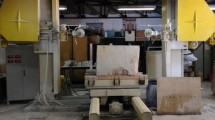Abstract
Some broken end mills with many brittle breakage sections were collected, and the geometry features of these sections were summed up. As for minor breakage, the breakage sections were narrow planes parallel to the tool edge, and the depths of breakage were shallow. As for severe breakage, it likely occurred near the edge tip; its breakage sections were approximate planes perpendicular to the bottom of tool and tilted approximately 35° to the bottom edge; moreover, the broken degree of section side near the rake face was heavier, while that near the flank face was slighter. By taking these geometry features into account, mathematical instantaneous expressions of cutting force for broken end mills were amended correspondingly. Then, with these expressions, it could be analyzed that, on one hand, the amount of material removed by broken edge segment declined and, on the other hand, its coefficient of cutting force rose; therefore, the instantaneous cutting force might be in reverse relation with broken degree, and in positive relation with feed, and also the removed material by the tooth following the broken one would rise. These results indicate that, if a tooth is brittle broken, there exist two kinds of possibility as rise and decline for its cutting force—the cutting force of slightly broken tooth would rise, while that of heavily broken tooth would decline, the cutting force of tooth following the broken one would always rise, and that of other teeth would remain the same. Using artificial tooth breakage, cutting tests of broken end mills were taken; the test results agreed with above conclusions. Conclusions of this study may be used in modifying indices of monitoring brittle breakage for end mills.
Similar content being viewed by others
References
Zhou JM, Andersson M, Stahl JE (1997) Cutting tool fracture prediction and strength evaluation by stress identification, part I: stress model. Int J Mach Tools Manuf 37(12):1691–1714
Ai X, Liu ZQ (1994) Characteristics of ceramic tool fracture. Key Eng Mater 96:165–196
Xu CH, Huang CZ, Ai X (2007) Cutting behavior and related cracks in wear and fracture of ceramic tool materials. Int J Adv Manuf Technol 32:1083–1089
Lin T-R (2000) Experimental study of burr formation and tool chipping in the face milling of stainless steel. J Mater Process Technol 108:12–20
Cui XB, Zhao J, Tian XH (2013) Cutting forces, chip formation, and tool wear in high-speed face milling of AISI H13 steel with CBN tools. Int J Adv Manuf Technol 64:1737–1749
Bai QS, Li K, Liang YC, Cheng K (2015) Wear and breakage behaviors of PCD small-diameter end-mill: a case study on machining 2A12 aluminum alloy. Int J Adv Manuf Technol 77:839–846
Sevilla-Camacho PY, Herrera-Ruiz G, Robles-Ocampo JB, Jáuregui-Correa JC (2011) Tool breakage detection in CNC high-speed milling based in feed-motor current signals. Int J Adv Manuf Technol 53:1141–1148
Sohyung C, Shihab A, Arzu O, Nandita K (2005) Tool breakage detection using support vector machine learning in a milling process. Int J Mach Tools Manuf 45:241–249
Prickett PW, Siddiqui RA, Grosvenor RI (2011) A microcontroller-based end milling cutter monitoring and management system. Int J Adv Manuf Technol 55:855–867
Dae-Kyum B, Tae-Jo K, Hee-Sool K (2000) Real time monitoring of tool breakage in a milling operation using a digital signal processor. J Mater Process Technol 100:266–272
Prickett PW, Johns C (1999) An overview of approached to end milling tool monitoring. Int J Mach Tools Manuf 39:105–122
Mathieu R, Sebastien G, Benoit F, Jean-Yves H (2006) A new versatile in-process monitoring system for milling. Int J Mach Tools Manuf 46:2026–2035
Lee BY, Tarng YS (1999) Milling cutter breakage detection by the discrete wavelet transform. Mechatronics 9:225–234
Kim GD, Chu CN (2001) In-process tool fracture monitoring in face milling using spindle motor current and tool fracture index. Int J Adv Manuf Technol 18:383–389
Yao-Wen H, Yang C-Y (2008) Prediction of tool breakage in face milling using support vector machine. Int J Adv Manuf Technol 37:872–880
Girardin F, Rémond D, Figal JF (2010) A new method for detecting tool wear and breakage in milling. Int J Mater Form 3(Suppl 1):463–466
de Jesús R-TR, Herrera-Ruiz G, Terol-Villalobos I, Jáuregui-Correa Juan C (2003) Driver current analysis for sensorless tool breakage monitoring of CNC milling machines. Int J Mach Tools Manuf 43:1529–1534
de Jesús R-TR, Herrera-Ruiz G, Terol-Villalobos I, Jáuregui-Correa Juan C (2004) FPGA based on-line tool breakage detection system for CNC milling machines. Mechatronics 14:439–454
Principe JC, Yoon T (1991) A new algorithm for the detection of tool breakage in milling. Int J Mach Tools Manuf 31(4):443–454
Chen JC, Black JT (1997) A fuzzy-nets in-process (FNIP) system for tool breakage monitoring in end-milling operations. Int J Mach Tools Manuf 37(6):783–800
Zhang DY, Han YT, Chen DC (1995) On-line detection of tool breakages using telemetering of cutting forces in milling. Int J Mach Tools Manuf 35(1):19–27
Jemielniak K (1999) Commercial tool condition monitoring systems. Int J Adv Manuf Technol 15:711–721
Engin S, Altintas Y (2001) Mechanics and dynamics of general milling cutters. Part I: helical end mills. Int J Mach Tools Manuf 41:2195–2212
Liu C, Wu JQ, Li GH, Tan GY (2013) Frequency-spectrum characteristics of force in end milling with tool wear and eccentricity. Int J Adv Manuf Technol 67:925–938
Wan M, Zhang WH, Qin GH, Tan G (2007) Efficient calibration of instantaneous cutting force coefficients and runout parameters for general end mills. Int J Mach Tools Manuf 47:1767–1776
Armarego EJA, Despande NP (1991) Computerized end milling force prediction with curing models allowing for eccentricity and curer deflections. Annals CIRP 40:25–29
Liu C, Wang F, Wu JQ, Liu HL, Tan GY (2014) An approach of static measuring radial and axial runouts for cylindrical mills after installation. Appl Mech Material 574:445–451
Author information
Authors and Affiliations
Corresponding authors
Rights and permissions
About this article
Cite this article
Liu, C., Wu, Jq., Liu, Hl. et al. Geometry features of breakage section and variation of cutting force for end mills after brittle breakage. Int J Adv Manuf Technol 84, 1345–1358 (2016). https://doi.org/10.1007/s00170-015-7726-6
Received:
Accepted:
Published:
Issue Date:
DOI: https://doi.org/10.1007/s00170-015-7726-6




